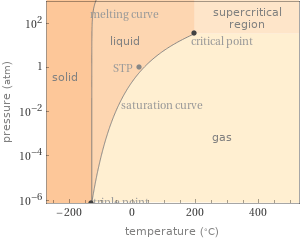Input interpretation

N-pentane | freezing point
Result

-129.67 °C (degrees Celsius)
Phase diagram

Phase diagram
Units

Unit conversions

143.48 K (kelvins)

-201.41 °F (degrees Fahrenheit)

258.26 °R (degrees Rankine)

-103.74 °Ré (degrees Réaumur)

-60.577 °Rø (degrees Rømer)
Comparisons as temperature

35 °C below coldest recorded temperature on Earth (-94.7 °C)

5 °C above Hg-Tl-Ba-Ca-Cu-oxide superconducting temperature (138 K)

18 °C above Tl-Ba-Cu-oxide superconducting temperature (125 K)
Corresponding quantities

Thermodynamic energy E from E = kT: | 12 meV (millielectronvolts)

Blackbody energy flux Φ from Φ = σT^4: | 24 W/m^2 (watts per square meter)

Approximate luminous exitance from a planar blackbody radiator perpendicular to its surface: | 1.7×10^-51 lx (lux)